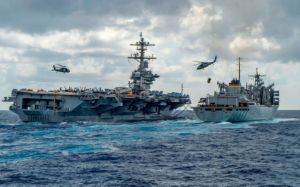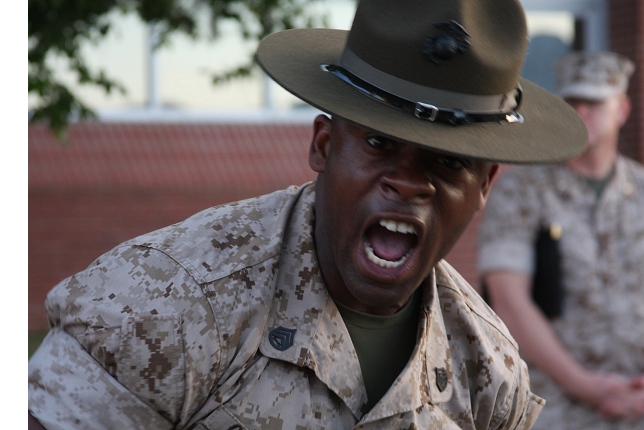[by J. Scott Shipman]
.
In April of 2017 I was honored to speak at a
Naval Postgraduate School Littoral Operations Center “Littoral Op-Tech” event in Cartagena, Columbia. This was supposed to be my last Op-tech event, as I was winding down the effort to make our submersible boat a reality. As it turned out, I was in Halifax, Nova Scotia about a year later—and that was my swan song.
.
The core of this talk was based on four bullet points the late Wayne Hughes wrote on a piece of paper sometime in 2016 and asked me to deliver to VADM Tom Rowden. I had mentioned that I was scheduled to be in a meeting with the admiral the following week, so Wayne wrote four bullet points as points of departure for Admiral Rowden to consider as he attempted to execute his “distributed lethality” concept. The bullets were: Distributed Influence, Distributed Competition, Distributed Confrontation, and Distributed Interdiction. I made a copy and referred to them frequently and added to the list as I thought appropriate. Later in email correspondence, Wayne filled out his ideas of these bullet points and allowed me to use when I told him about this idea for the talk. These bullets are identified with (WPH).
.
As far as I know, Distributed Lethality as a focus evaporated when VADM Rowden retired, but in my opinion his initiative was refreshing and much needed. Perhaps this little missive will resurrect some interest and spark new interest.
.
If this collection of ideas seems a bit “all over the map,” it is because it is. The talk was meant to be given with slides, and to generate discussion. This is also my first foray back to blogging in too many years. I apologize in advance it this is too long and conversational—or too navy-centric. Charles left some big shoes to fill.
Setting the stage with quotes and ideas:
.
“…strikes may in all instances be necessary but they will not in all instances be sufficient to achieve a national military purpose…[and] a fleet is incomplete which has not elements that can operate in waters next to the enemy coast.” From Fleet Tactics and Coastal Combat, Second Edition, pg 249-250 by Wayne P. Hughes, Jr., CAPT, USN, Ret (emphasis added).
.
“Where missiles are concerned, the contest between the offense and defense is marked by a serious differential in starting points. In practical terms, the offense has a huge and nearly motionless target to hit and needs to hit it only once. One large missile warhead is equivalent to something like five or ten direct hits by a sixteen-inch gun. The defense, on the other hand, is required to intercept an extremely fast and quite agile flying object, sometimes hardly detectable in the various phases of its trajectory, which can be launched from any operational dimension and often—for design purposes, every time—completely by surprise.” From The Littoral Arena; A Word of Caution, by RADM Yedidia “Didi” Ya’ari, Israel Navy, Naval War College Review, Summer 2014 (emphasis added) (this was a reprint suggested by Wayne Hughes who wrote, A Prophet For Our Times to accompany the rerelease.)
.
“Future wars in which LRPS (Long Range Precision Strike) systems predominate will involve efforts by all sides to find adversary platforms while hiding their own from the enemy’s ISR and targeting systems. In the “hider/finder” competition, a mobile platform that can hide in clutter (such as environmental or electromagnetic noise, dense traffic areas, on and under the water, etc.) will likely survive and be capable of offensive action. This will become the paramount element in contested seas, straits, and littorals. The offensive action of targeting and counter targeting is decisive, and no navy ever triumphed at sea without having the offensive advantage.” RADM Walter E. Carter, Proceedings, May 2014
.
These three quotes identify challenges that are just the tip of the iceberg one must encounter if there is any hope of success in the littorals. If history is our guide, the littorals are a life and death environment. Whether a defender or an aggressor, how a navy fights in coastal green water more often than not decides who wins and who loses.
.
.
“For more power in more places, the Navy should increase the offensive might of the surface force and employ ships in dispersed formations known as ‘hunter-killer surface action groups.’
.
With respect to VADM Rowden, I would suggest a slight modification:
.
“For more power in more places, the Navy should increase the offensive might of the surface and subsurface forces and employ ships in dispersed formations known as ‘hunter-killer surface action groups.”
.
These hunter-killer action groups would be an elegant solution to challenges faced in the littorals. So let us quickly examine some of the attributes and advantages Distributed Lethality brings, bearing in mind many of these examples overlap.
.
Distributable Options. The number of platforms will often determine the number of options available to leadership. Fewer platforms limits options in an almost binary fashion—ships are either available or not. As magnificent as some of our big deck multipurpose warships are, they can’t be in two places at once. The more ships, the more choices and the more flexibility across the spectrum.
.
Distributable Presence. Presence is a message without words. The Freedom of Navigation Operations conducted in the South China Sea recently are a good example of the power of presence to send an unmistakable message. As William Beasley wisely suggested in the November 2015 issue of Proceedings, the US Navy needs to “close the presence gap.” Beasley “steals” a line from former Naval War College Dean CAPT Barney Rubel and defines “presence” — “it means being there.”
.
Distributable Influence. (WPH) A large number of affordable surface [ JSS: and subsurface] ships can be widely distributed—or aggregated—on demand anywhere in the world where our presence is wanted and we are needed. I added subsurface ships to Wayne’s list because knowledge of the potential for additional subsurface presence will influence the decision-making process of an adversary.
.
Distributable Competition. (WPH) A large number of lethal ships that are capable of cooperating to make sneak attacks using a wide variety of targeting capabilities, and can be based forward in peacetime at small cost in friendly ports.
.
Distributable OODA. John Boyd’s OODA loop for Observe, Orient, Decide, and Act is a complex, yet simple diagram of decision making (or learning) and engagement. The larger point I want to illustrate with this slide is the power of Distributable Situational Awareness (observe) (manned or unmanned), Distributable Orientation (multiplied across platforms) (mostly manned, but aspects could be assigned to an algorithm), Distributable Decisions, and Distributable Action (manned or unmanned). Implicit in OODA is explicit knowledge of Commander’s Intent, where individual Commanding Officers possess the knowledge and capability to execute Commander’s Intent throughout the full spectrum of options.
.
Armed with their commander’s intent, their human senses and ship sensors a ship’s captain will possess a level of adaptability/flexibility that we will never be able to pre-program into an unmanned system, or implement from remote control. From the Battle of Salamis over 2,000 years ago to the War on Terror, the history of warfare is replete with examples of human ingenuity and bravery overcoming what seemed like at the time impossible odds. As CAPT Frank Andrews wrote in a 1958 Proceedings article:
.
“But let no one forget that one and only one element will finally sway the balance, when a country must defend the things for which it stands. That element is people, people who believe, people who will act, people who can think, people who have what it takes to outfight the enemy.”
.
We believe there are roles for unmanned vehicles, but we advocate manned solutions over automation for there are things people can do that computers will never be able to do, make no mistake: our people are our edge. In the event of hostilities, navies will need resilient and survivable platforms to adapt, scout, and attack and create:
.
Distributable Uncertainty. War is the business of the previously unthinkable. If history is any guide, man’s unmitigated barbarity and ability to conjure novel methods of death and destruction will continue. The outcomes won’t change, though the methods and pace will stagger our sensibilities, so we might as well stagger the enemy first. Shaping the mind of the adversary, in his planning and assumptions. The benefit of creating uncertainty is the creation of novelty in the mind of the adversary.
.
Distributable Confrontation. (WPH) A large number of lethal ships the enemy understands will attack his fleet and commerce if shooting starts the larger number of lethal ships will conduct lethal attacks at an affordable cost to us and he is forced to devote his time and energy to defending against an attack at a time and place of our choosing with a force large enough to cause him great loss. The late naval strategist Herbert Rosinski said:
.
“At sea there is no halfway house between victory and defeat, because there is no difference between what is needed for defense and what for attack. One side only can gain security at the cost of the other—or neither.”
.
Distributable Interdiction. (WPH) Ships that will team with international partners to assert the right level of maritime interdiction all the way from occasional inspections up to a full distant quarantine or blockade.
.
Distributable Deterrence. A credibly armed Fleet, large enough to be distributed/dispersed should dissuade any potential adversary of the inherent folly and hazard of engagement.
As Colin Gray points out, “with deterrence the enemy gets a vote.” Deterrence is connected at the hip with credibility. Credible people, doctrine, ships and weapons combine to establish deterrence in the mind of the adversary. The best fight is the one that never occurs, where angst and second-guessing are artifacts for the historians.
.
Back to Nuts and Bolts, or as a friend in the intel community called “ground truth”
.
An affordable and executable set of solutions will be needed to make the most of these ideas. We believe essential elements of these action groups should be a combination of manned and optionally manned, subsurface and surface platforms. For the subsurface vehicles the price per hull should not exceed $250M and for the surface platforms the price should not exceed $100M (though we should aim for $70M). We should buy these ships in numbers. The broad concept of operations for these vehicles would be to operate and compliment our growing number of unmanned underwater vehicles, and our SSNs, where appropriate.
.
For the subsurface realm we have concept model we call a “Hoss Boat:” a small, stealthy, air breathing lightly manned submersible boat designed to operate and fight on the surface or submerged. Our boats have a long surfaced endurance, able to patrol or project force in the littorals as a real-time, networked asset.
Since Hoss boats are small they can operate in shallow coastal water (in the 20-10 fathom curve range). Our boat combines stealth and persistence on station to greatly complicate a potential enemy’s tactical situation. Hoss Boats can hide in coastal clutter such as environmental or electromagnetic noise, dense traffic areas, the hundreds of islands in the SCS (or the Baltic Sea) to increase stealth in places where we’d probably never send an SSN or traditional SSK. Since she can hide on and under the water, unlike a traditional surface craft in the same environment she would likely survive and be capable of persistent offensive action.
.
.
We planned her initial primary mission to be anti-surface ship (ASuW) warfare, holding at risk both combatants and when appropriate, other surface assets. She would also have a robust AA capability for air threats. This boat could also be used for scouting/ISR missions operating as a real-time, networked asset, although she is not bandwidth or network dependent and will be able to independently detect and destroy adversaries. We believe these boats could be built for about $250M per hull, considerably less than SSK/AIP solutions, and the resources required to deter them would have a favorable affect on would-be belligerents.
.
Recently we added a small surface missile boat to our portfolio of possibilities, with the working moniker Hoss-Surface. While this boat has not been drawn her mission sets are similar in some respects to the submersible, and radically different in others. While both will have an anti-ship mission, the surface boat should have variants allowing for additional missions (ASW-MIW, for instance). Given the environments where she will operate, the radar cross section should be reduced as much as possible. Compared to an LCS, she won’t be fast at a modest 25 knots. Her main battery should include at least eight Norwegian naval strike-type anti-ship missiles and the largest gun the design will allow, but 30 caliber minimum. Our working price estimate is less than $70M per hull.
.
Both of these boats can provide navies with a needed capability to distribute lethality that are survivable and offers more offensive flexibility at a lower cost. Lightly manned and highly automated, our boats would provide a “man-in-the-loop” level of situational awareness. It would be appropriate to interject here that instead of a binary choice manned or unmanned, both designs should be capable of working in concert with unmanned vehicles across the spectrum and incorporate “optional manning” as initial design consideration.
.
The title of this talk describes Distributed Lethality as “elegant,” as indeed it is, but Distributed Lethality will continue to be a myth if at least three significant obstacles aren’t overcome. (1) No budget growth, (2) an acquisition process is too slow and complex (3) hard force structure choices. The Navy cannot control the first two without Congressional support, which will not happen quickly. Thankfully, within the Navy a fairly vigorous debate on force structure is on-going. If we frame the force structure debate through the prism of a Winston Churchill quote: “Now that we have run out of money we have to think,” our predicament comes into sharp relief and alternatives appear. Trust me: poverty focuses the mind.
.
To its credit US Navy has embraced innovative technologies, but in ship building we have over-specialized (mostly because of economy) in large-deck multipurpose warships that are so complex and expensive they take years to design and build and of such value that every ship becomes a capital ship—too precious to send into harm’s way when the purpose of a warship is to fight and win when necessary. In too many cases, the budget will not endure the addition of the number or ships necessary meet our commitments using existing plans and acquisition assumptions/processes.
.
It would seem the less complex and expensive alternatives we have suggested would fit the bill, if only we could speed up the acquisition process. There must be a way. Why? Because the status quo is not sustainable, safe, nor secure. How can we overcome these problems and challenges?
We could begin by casting off what Angus K. Ross called some of our “lazy assumptions.” In an institutional bureaucracy like the Pentagon; lazy assumptions are ubiquitous because they are the path of least resistance. Some examples: the status quo is fine, we can shape any environment, our current acquisition process of buying/building ships optimizes for budget scarcity, unmanned will make all our dreams come true, etc., etc. At the risk of trafficking in clichés: If everyone is saying the same thing, someone isn’t thinking.
.
.
One immediate benefit to less complex ships would be shorter times between design, build and deployment. Right now the cycle time between design and deployment is approaching 20 years—where obsolescence can invalidate a solution before it hits the Fleet. There used to be a phrase, “low cost, technically acceptable,” and we would do well to remember as we move forward.
.
Distributed Lethality properly deployed is the marriage of the strategic and the tactical. While more platforms options to distribute will largely be a function of strategic force structure planning, the capabilities conveyed by the increase in available ships provides tactical commanders on the scene who can adapt and attack—as their decisions more often than not decide who prevails.
.
Distributed Lethality is elegant precisely because increased numbers of ships and the capability to adapt on the fly to achieve our ends: maritime dominance.
If we were to take a poll from the representatives of the militaries represented here today and asked if you want your navy to have more options and firepower in your area of responsibility my guess is there would be a resounding “YES.”
.
We need alternatives and will stipulate there are many from which to choose. Our boats would be a cost effective way to influence war in the littorals in our favor, but there are other solutions to be sure.
.
Making Distributed Lethality a reality is within our grasp if we possess the imagination to reach beyond the status quo and think differently. As Marc Andreessen once said,
“True innovations don’t follow a pattern.” Our platforms and options offered by others are an innovation in how to fight that does not follow a prescribed pattern. On the subsurface front, as a student of military history I believe we’re reaching the point when an offensively disposed subsurface force will be needed in growing numbers. In a world of ubiquitous precision-guided munitions, surface ships will be increasingly at risk in areas where navies will need to have eyes and potentially provide fires—specifically in contested coastal shallow waters—the littorals. All navies will need a deeper subsurface bench. We need also to explore surface design alternatives that are
affordable and stealthy enough.
.
The USN needs manned highly capable submersible craft and stealthy small missile boats that can be bought in numbers, to achieve a lethal, numerous and credible presence that can dramatically change warfare in the littorals.


















